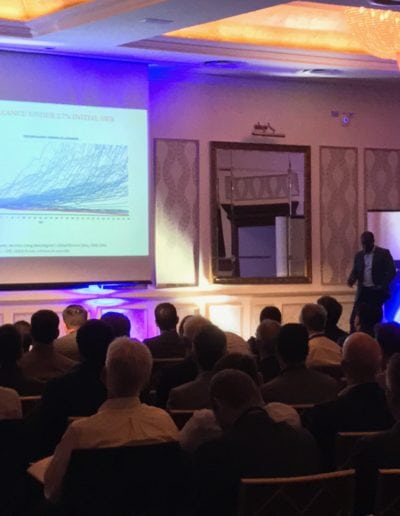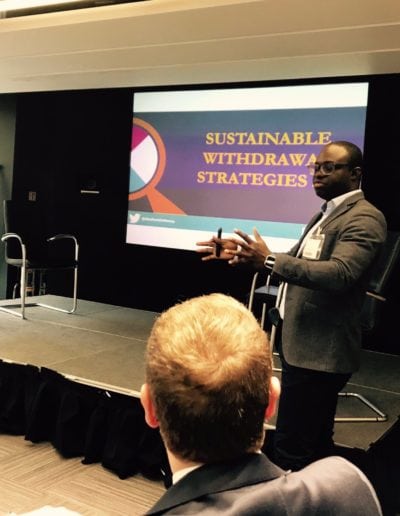Hello There!
Abraham Okusanya
MSc, AFPS, MCSI
He has authored several industry papers and delivered talks to the Financial Conduct Authority (FCA), Chartered Insurance Institute (CISI), Personal Finance Society (PFS), The Association of British Insurers (ABI), Chartered Institute for Securities & Investment (CISI) and several conferences in the UK, Ireland and Luxemburg. He holds Master’s degree from Coventry and an alphabet soup of designations, including the IMC and Chartered Wealth Manager. But of course, no one really cares.
“Retirememt planning used to be so simple”
Media Gallery

Presentation Topics
Beyond the 4% rule: Sustainable Withdrawal Strategies from Bengen to Kitces
Duration: 45 – 60 mins
Since Bill Bengen pioneered the ‘safe’ withdrawal rate research in 1994, researchers have developed several adaptations to the original framework, from the Guardrail strategies developed by financial planner Jon Guyton, to the Ratcheting rule developed by Michael Kitces. Further research identified that spending tends to decline progressively in retirement. This led researchers to coin terms such as the ‘Go-Go’ years, ‘Slow-Go’ years and the ‘No-Go’ years, to describe the unique phases in retirement.
This session is a deep dive into the research behind the sustainable withdrawal rate framework including:
– Summary of the pros and cons of main flexible withdrawal strategies
– Impact of fees, asset allocation and market valuation metric
– Adjusting withdrawal rates for longevity
– Aged-banded approach to retirement withdrawal
– Crafting a personalised Withdrawal Policy Statement
Technology Solutions for Illustrating Withdrawal Rate Strategies
Duration: 30 mins
Technology is transforming the way we deliver retirement planning. This session focuses on how new technology tools helps advisers illustrate sustainable withdrawal strategies in retirement portfolios. New software solutions have recently emerged for financial advisors, specifically to illustrate and personalise withdrawal rate strategies to a client’s unique circumstances. Advisers are able to model the impact of varying assumptions, from a wider range of asset classes, to the impact of investment expense ratios and advisory fees, and time horizons that may be longer or shorter than the conventional 30 years. The next wave will enable advisers to optimize, automate and track retirement income strategies.
Cash reserve buffers, bucketing and old wives’ fables for retirement portfolios
Duration: 45 – 60 mins
Managing retirement income portfolios is riddled with old wives’ fables; practices handed down from adviser to adviser but with very little empirical basis.
This presentation will explore the common practices in managing retirement portfolios including cash buffer, rebalancing and asset allocation glidepath.
Using extensive evidence, the presentation will provide insight on what works and what doesn’t when mitigating sequence risk and improving the sustainability of a retirement portfolio.
How do we help the Clients Prepare for the Next Financial Crisis
Duration: 30 – 40mins
A crisis is coming! In the coming years, there is going to be a major financial crisis that will bring the capital markets to their knees. There’ll be a lot of panic. Your clients’ portfolios will take a beating. They’ll be angry and confused. Like most investors, they’ll look for someone to blame. The easy target would be you, the financial advisers. This presentation is designed to outline simple, practical, easily implementable strategies to help advisers and clients cope effectively with the next financial crisis, whenever it comes! The premise is that the capital market almost always rewards patient investors in the longer term. However, too many investors miss out on this because the panic and bail out when the going gets tough.
where i am
Suite 1SC Southgate House
88 Town Square
Basildon
Essex SS14 1BN
Contact info
01268 502 454
abraham@finalytiq.co.uk
Cotact Hours
M – F : 8am–5pm
Sat : 12am–3pm
Sun : Unavaliable









